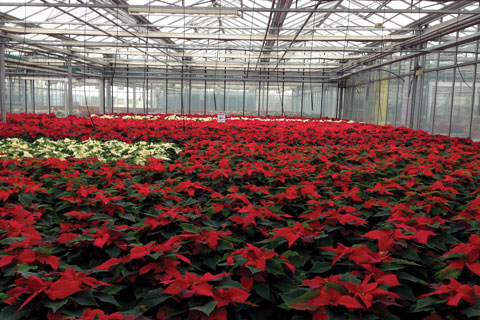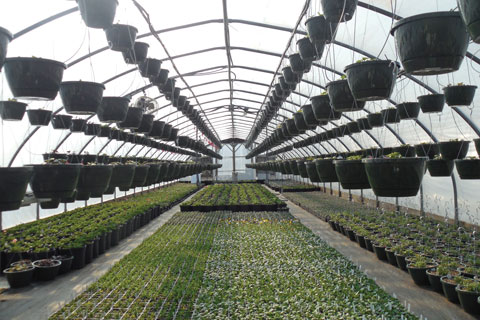9/1/2018
Inputs on Demand
Joachim Nachmansohn

When it comes to propagation of young seedlings or plants, there are often some misunderstandings when it comes to resource use management, such as soil, irrigation and fertilizing practices.
I’m not talking about practices related to unique details of planting a seed, an offshoot or seedling—that’s obviously a unique part of cultivation that’s different from the rest of the aspects of nursing plants throughout the cultivation cycle.
But aside from that, the principles are really the same; the plants need a perpetual influx of light, water and plant nutrients to accommodate their needs, as well as a soil or medium composition that allows them to thrive. And a young plant needs all of this in a well-balanced flow of  doses matching its demand, just like a finished plant.
doses matching its demand, just like a finished plant.
In the photos, you see one greenhouse with different flower plantlets and another with mature poinsettias. In both cases, resource management and standard practices can, and should be, the same.
I’ve realized that many professionals forget that the crops need the same basic approach in the propagation phase as in the other phases. It doesn’t matter if it’s growers or horticulturists; many professionals often make a point that young plants have special needs and demand for protection. However, that isn’t correct if it implies that the plant has special needs and demand for protection that a larger and more mature plant doesn’t have.
Some misunderstandings
Let’s explore this by deconstructing some misunderstandings. First, let’s address the overall misunderstanding that the seedling or plantlet is weak. This isn’t entirely correct. Sure, it’s smaller, and as such, there’s less tissue that needs to be damaged in order to have the plant killed. But a very young plant is full of life and capacity to grow—just think about flowers that can make their way through paved roads.
Be that as it may, you say, surely a small plant is more sensitive to drought. Well, not really—at least not in principle more than more mature plants. Or put another way, all plants are sensitive to acute water stress if it’s not alleviated, but that makes no difference for plantlets or more mature plants.
There’s no difference in the method of preventing drought stress for a small plantlet in greenhouse production compared to a large plant; you use a good soil—often with high organic content that enables good water and nutrient holding capacity—and you manage irrigation in such a way that the soil is moist, but not soaking wet. So, yes, access to water is important for a plantlet, as it is for all plants.
The same reasoning goes for sensitivity to high salinity levels. If too much commercial fertilizer is added at a single time, it can have a negative impact on the crop, as it basically has the same effect as salting the soil. Therefore, you might get the recommendation to avoid high doses in the beginning, as it can damage the plantlet. But again, this is in no way unique to immature plants—it’s true for all plants—and the best way to avoid it is to supply doses on demand.
How should we do it then?
So how should we manage inputs when it comes to propagation? In short, the same as always. In abstract terms it means always sufficient, but not excessive, amounts of water and nutrients, a soil or medium that’s neither too compact nor too lush with decent temperatures in the greenhouse, etc. In concrete terms, it depends on what system you have in your greenhouse.
If you use fertigation, the procedure is very straight forward—you simply add doses that match the demand for water and nutrients until the next fertigation application. Depending on the size of the pot, the soil and other factors that determine the frequency, this can be done in several ways. If drip-irrigation technology is in place, you can simply use an algorithm that regulates the supply with whatever precision you like.
If the fertigation is done manually and performed, let’s say daily, the amount should be enough to sustain field capacity in the pots. That means to irrigate just to the level when the pot starts to drain. In this case, the quality of the soil medium is of more importance, as the water-holding capacity of the soil must be able to sustain delivery of water to the roots that initially can be small and shallow.
Regardless of how you manage fertigation, try to do it as demand-driven as possible. A simple way to do this is to fertigate with high frequency and low concentrations throughout the whole production cycle, all the way from day one at planting up until harvest/sale. This ensures not only a good start and a healthy growth, but also a good nutrient status in the plant when it’s time to cultivate it in the next stage of production.
Another benefit of this approach is that you don’t need to invest in an expensive, pre-fertilized soil. However, if you don’t utilize fertigation, a pre-fertilized soil is an excellent insurance that there will be access to nutrients in the beginning of the plants’ life-cycle. By pre-fertilized soil, I mean pre-fertilized for propagation and not heavily fertilized. Furthermore, don’t rely on this for a longer period of time, but be sure to manage the fertilization early on.
Control-release granular fertilizers are very neat when working with pots if you don’t use fertigation. Simply calculate the dose that the plant needs as long as it’s in the pot and add it from the beginning. Be sure to irrigate properly and you’ve ensured good water and nutrient status throughout the whole process with one simple method that’s the same for all stages of propagation.
It’s also possible to work with traditional granular fertilizers as well, or fully pre-fertilized soil (organic as well as conventional), but the risk of significant nutrient losses via the drainage water is quite high. And leaching is bad both for production and the environment, as we all know.
Punchline
Regardless of exact approach, we want a neat production form, and sometimes, that’s more essential than exactly accommodating the plant need, especially when it comes to propagation, so the approach must always be adapted to your system. In propagation, the target isn’t maximum yield or anything similar to that.
Really what we want is to optimize growth and vitality, enabling ourselves to propagate as many plantlets as possible, regardless if we’re propagating ornamentals or edibles.
My main message is this: The basic approach to accommodate the need of the plant in propagation is the same as always—supply the inputs in accordance with the demand. GT
Joachim Nachmansohn works internationally as a fertilizer and soil and water management expert. Through his company, Nachmansohn Consulting & Co., he, among other things, works with spreading accurate knowledge and skills on how to improve fertilizer use. His unique specialty is Demand-Driven Fertilization. He can be reached at consulting@joachimnachmansohn.com or visit www.joachimnachmansohn.com.